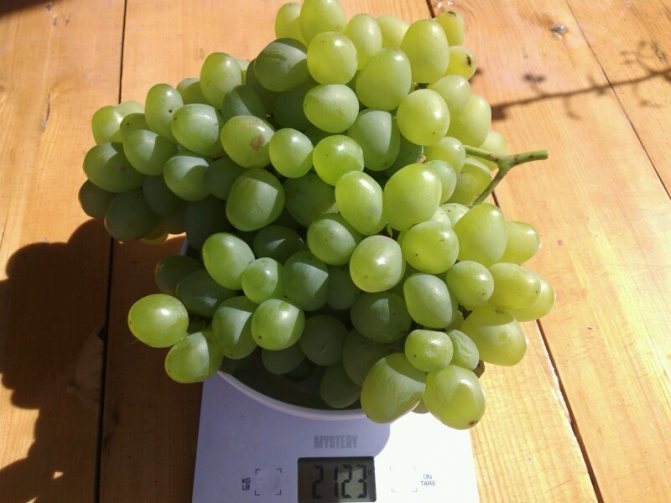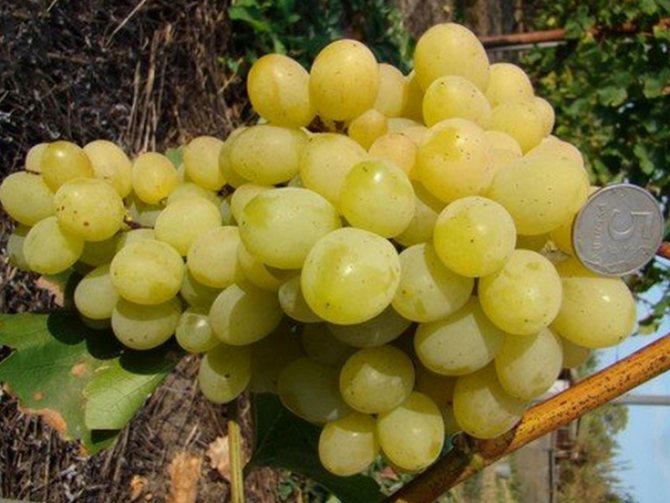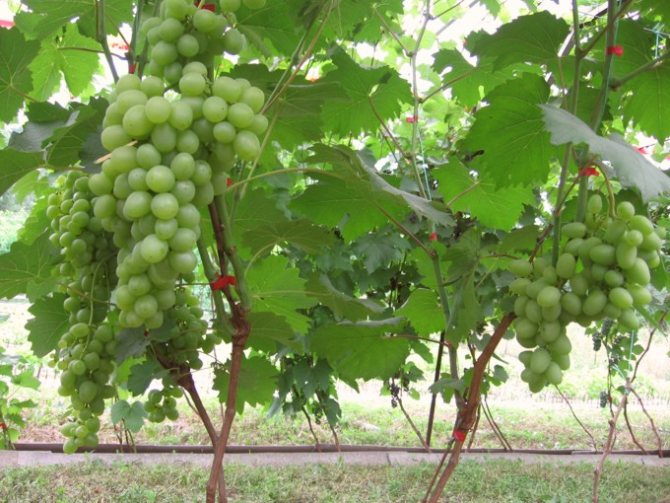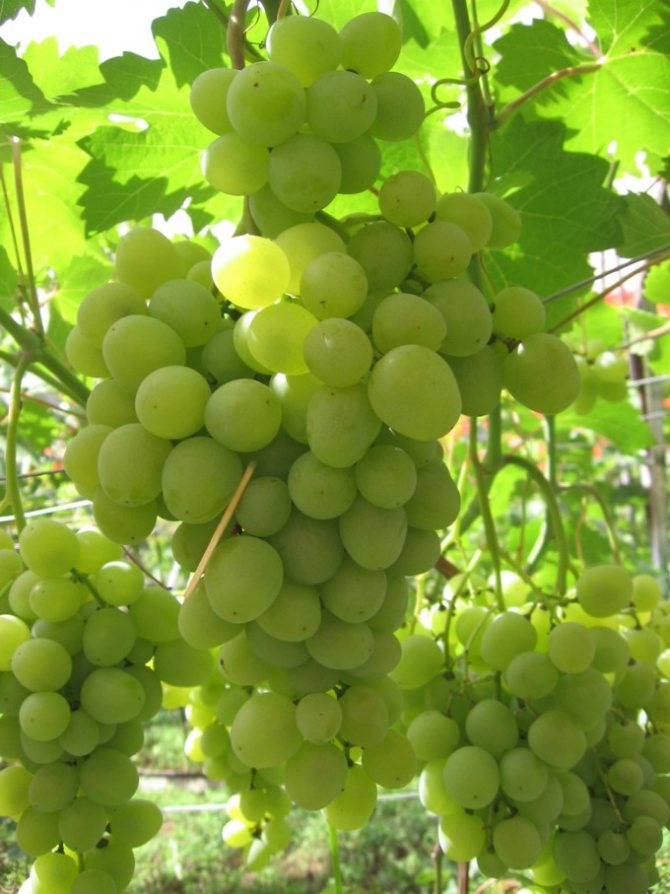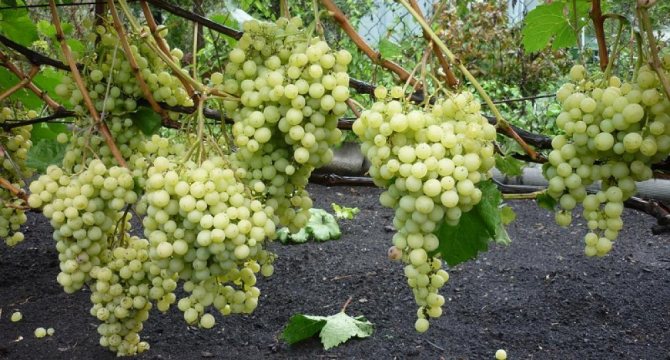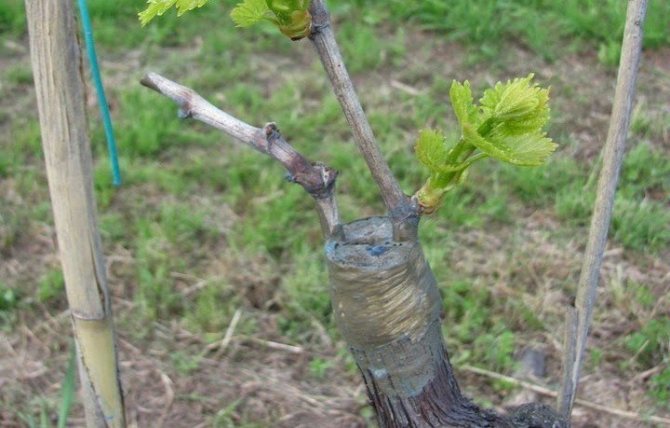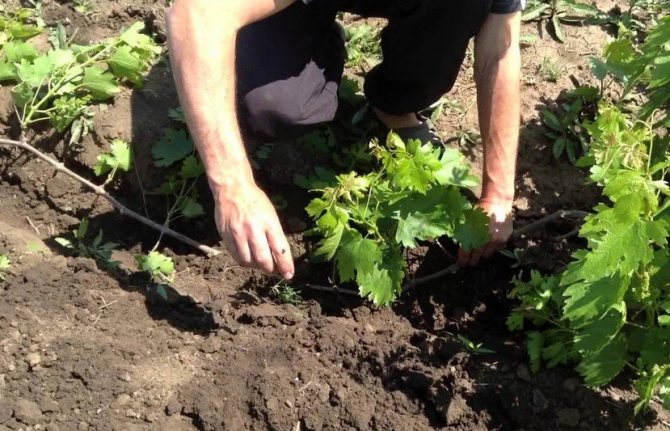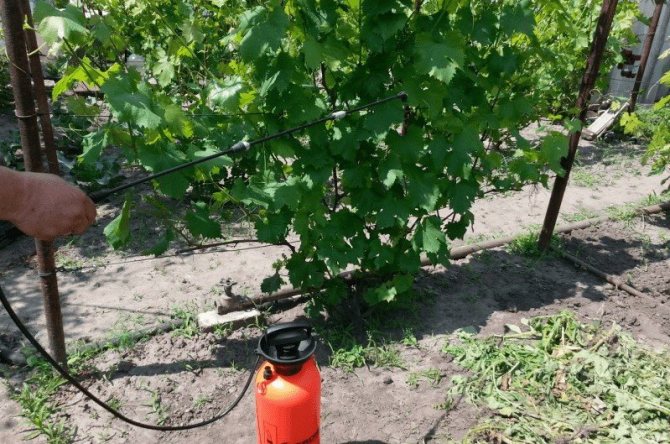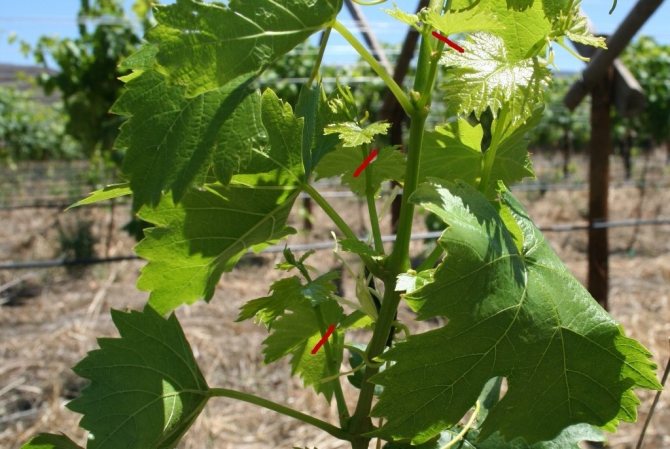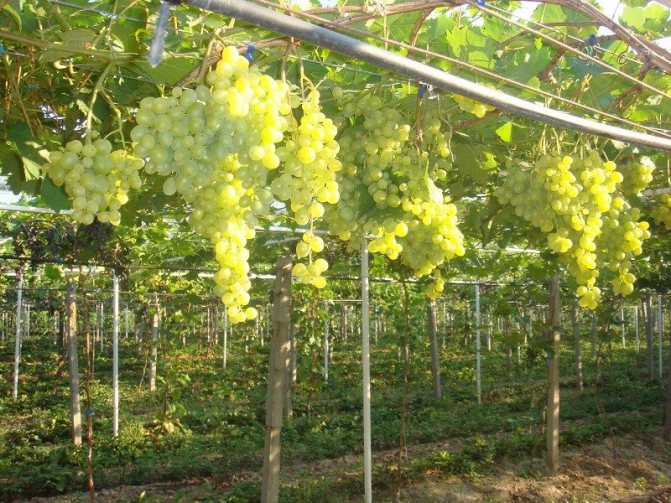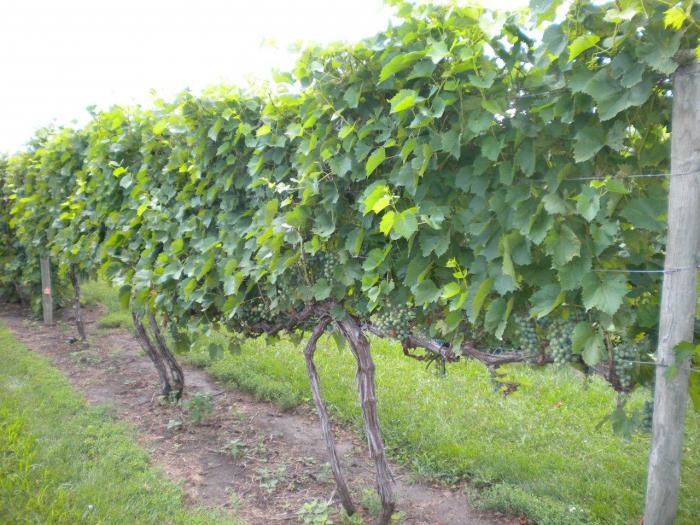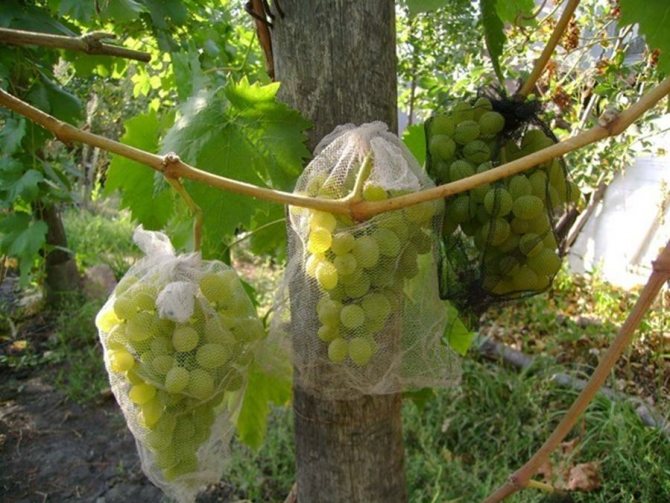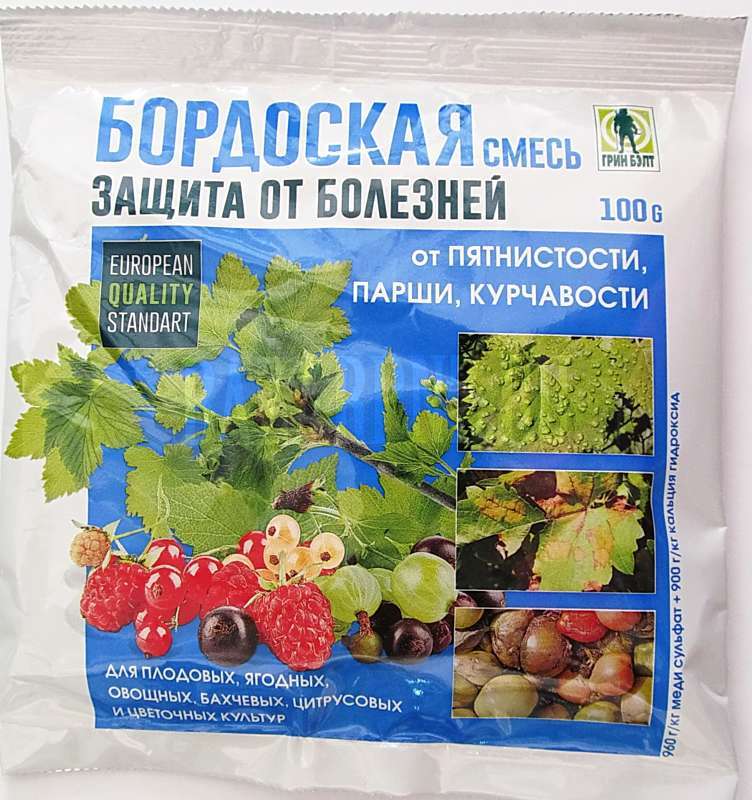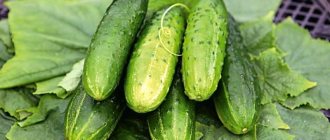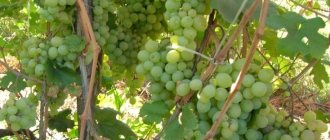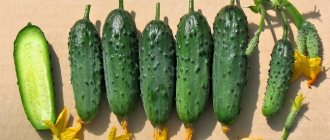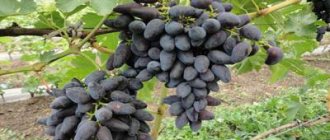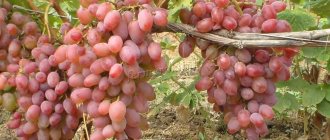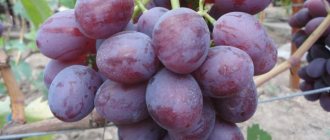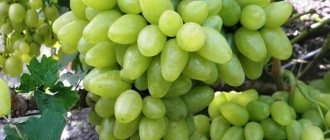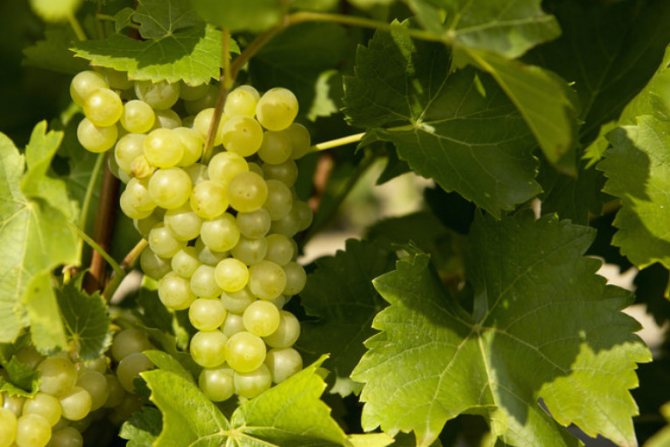
The grape variety "Super Extra" was brought out by the breeder from the Rostov region Pavlovsky E.G. To get a hybrid of berry culture, he dusty the varieties "Talisman" and "Cardinal". In various sources, you can find its second name - "Citrine". The plant has been zoned for cultivation in all regions of Russia.
It gained its popularity due to the excellent taste of the fruit, resistance to diseases and adverse weather conditions.
Breeding history
The variety is the result of the work of E.G. Pavlovsky, belongs to the most successful hybrid forms. This is due to such characteristics as high yield and large-fruited, resistance to many diseases.


He adopted the best qualities from mother plants, which were used as Cardinal and Talisman, as well as a mixture of pollen from other table forms. Initially, the novelty was named "Super-Extra", later the second hybrid was assigned - "Citrine", which is practically not used today.
Advantages and disadvantages of the variety
Super Extra is distinguished by its early maturity and ability to adapt to all kinds of climatic conditions, as well as high yield.
- In addition, the positive qualities of the variety include:
- uniform ripening of the bunch along the entire length;
- ability to withstand frosts down to –24 ° С;
- the possibility of transportation over long distances without losing the presentation;
- high (up to 18%) sugar content in berries;
- immunity to common grape diseases such as oidium and mildew.
Did you know? Grapes are the only plants on our planet that have been honored with the creation of a whole science in their honor - ampelography.
- The few disadvantages of the variety are usually ranked as:
- susceptibility to phylloxera disease;
- different sizes of berries on the brush, which are smaller, the lower they are;
- the toughness of the skin on the berries
Description
By the timing of the ripening of the crop, the variety belongs to the superearly crops, as a rule, in the southern latitudes by mid-late July, the berries are already fully ready for harvest. The growing season for bushes lasts from 90 to 105 days. Such characteristics make it possible to cultivate the hybrid everywhere, including the northern regions, where the crop can be harvested closer to mid-August.
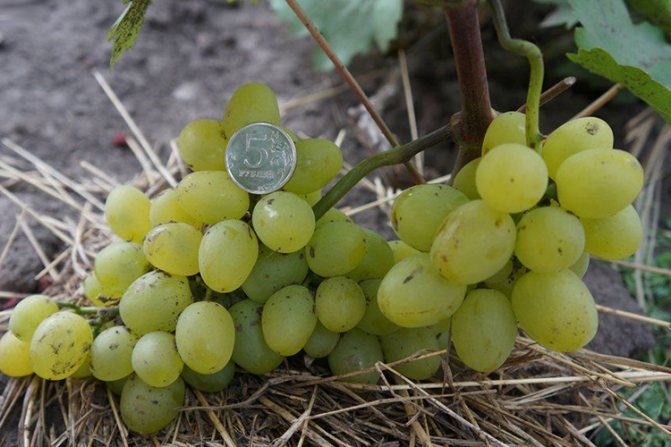

The bushes of the hybrid develop quickly, the shoots are powerful, but they need to be tied up. Also, its root system is distinguished by its large size.
The vine ripens even in cool summers. On one shoot, several ovaries are formed, rationing is carried out by pinching extra brushes at the initial stage of their development.
The culture blooms with bisexual flowers, therefore it does not need to be planted with a number of pollinating plants. The foliage is medium in size, the plate is slightly dissected, painted in a deep green color.
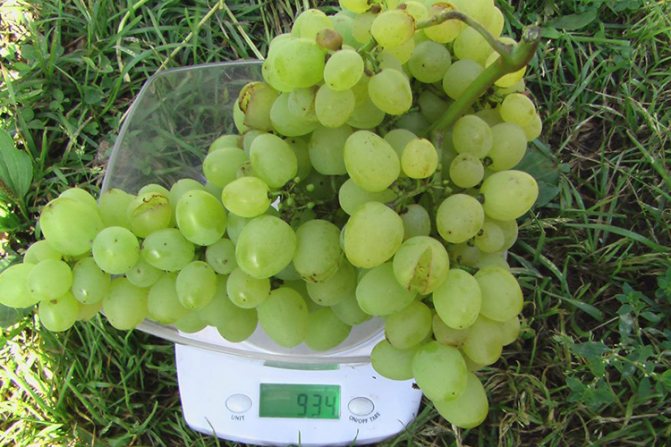

The mass of one brush varies from 500-1500 g. The berries are large, egg-shaped, the weight of one will be 8-12 g. The color of the peel is predominantly light green, sometimes almost white. The pulp is juicy and fleshy, the taste is harmonious, the signs of nutmeg are poorly expressed. The acidity remains at the level of 5.6 g / l, with a sugar content of 10-18%.
The bush is capable of bearing fruit for 2-3 years after planting in open ground. The yield of an adult plant will be about 18-20 kg.The grapes will be harvested annually. The dense skin allows it to be transported over long distances. Berries have a universal purpose, therefore, they are suitable for fresh consumption, as well as for subsequent processing, including the preparation of wines.
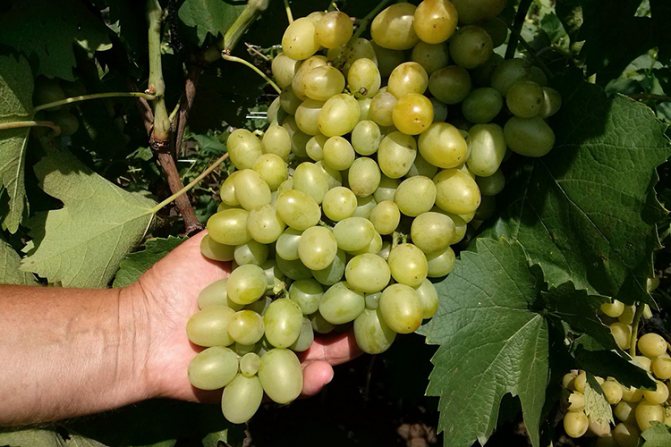

The bunches are formed in a conical shape, with a moderate density, the presence of branches is allowed. In a rainy summer, the brushes can become loose, the berries develop in different shapes. The variety requires mandatory rationing of the crop, which will avoid excessive stress on the shoots. The formation of a stepchild's harvest is characteristic of the hybrid.
The grapes are able to remain viable in the winter months without shelter when the air temperature drops to -25C.
Appearance of the variety
It is impossible to imagine the features of Super Extra grapes without a description of the photo variety and reviews about it.
It is with the description and characteristics that we will begin the conversation:
- Bushes of early ripening grapes are vigorous. Young shoots are light green, older ones are light brown. Growing grapes can be recognized by their rich green leaves. They have five lobes; no strong dissection is observed.
- The bunches are large, the usual weight of berries in a brush is 500-800 grams. But Extras also have record-holders who grow up to one and a half kilograms. In the photo below, a medium-sized Super Extra grape cluster.
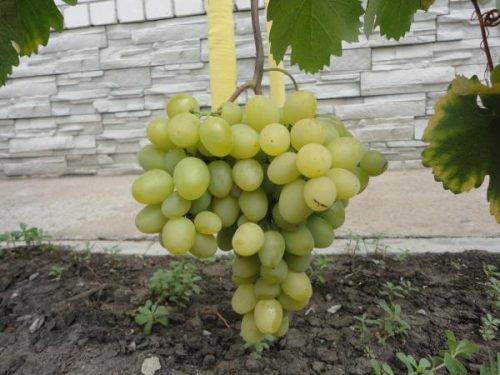

- According to the description of the variety, the grapes of Super Extra grapes are similar to Arcadia in color and size. They have an ovoid elongated shape. The length of the berry reaches 3.5 cm, and the width is about 2.5. One grape white with a golden sheen weighs 7-10 grams.
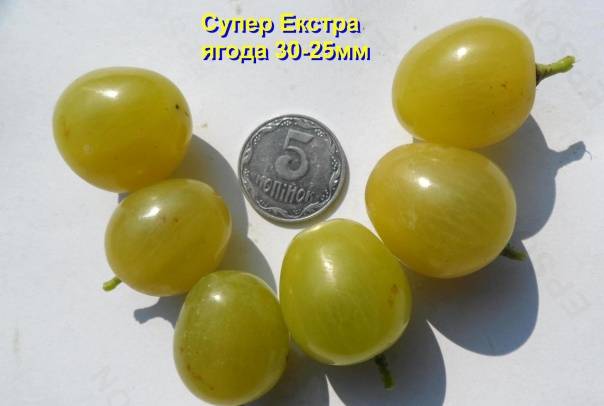

- The skin is hard, but when eaten it is not very noticeable. This characteristic (hardness) is very good for transportation.
- The Super Extra grapes are distinguished by their fleshy pulp. The taste is simple, the berries are surprisingly sweet. It is by taste that the variety can be distinguished from Arcadia.
Landing features
Super-Extra takes root in a similar way to other table grape varieties.
Landing dates
April will be the right time for disembarkation. An alternative option would be the autumn planting of seedlings. Healthy planting material takes root well not only in spring, but also when rooting at the end of the season. However, it is recommended to adjust the timing of the work carried out depending on the climatic characteristics of the region.
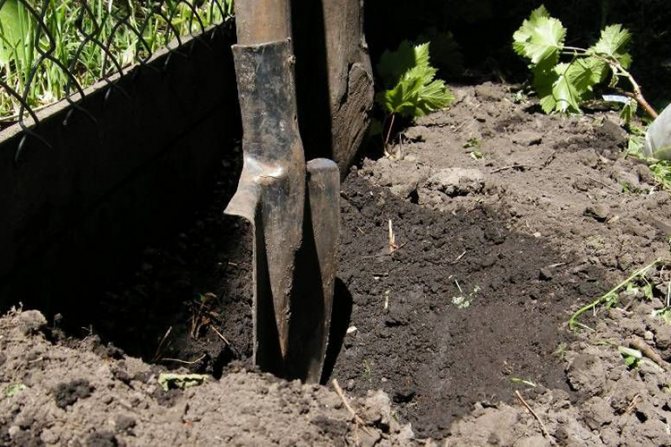

Site selection
Considering the possible layout of the vineyard, it is worth considering the tendency of the hybrid to grow rapidly. It is more correct to root it from the south or southwest side, near buildings or fences that can protect the plantings from the cold wind.
If the bushes are planted near buildings, the distance from the foundation should be at least 2 m. The variety can also be grown on free-standing arches or gazebos.
The berries require a lot of light to ripen, so you should avoid neighborhoods with large trees shading the vineyard. When rooting several seedlings, the step between them should be at least 1.5 m, with a distance between rows of about 3 m.
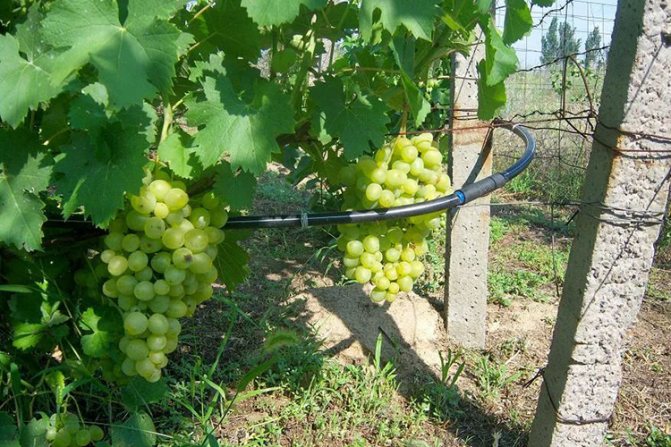

Choosing the right soil
The key to a good and stable harvest will be fertile land that can retain moisture for a long time. To enrich the soil with nutrients, compost can be added to it.
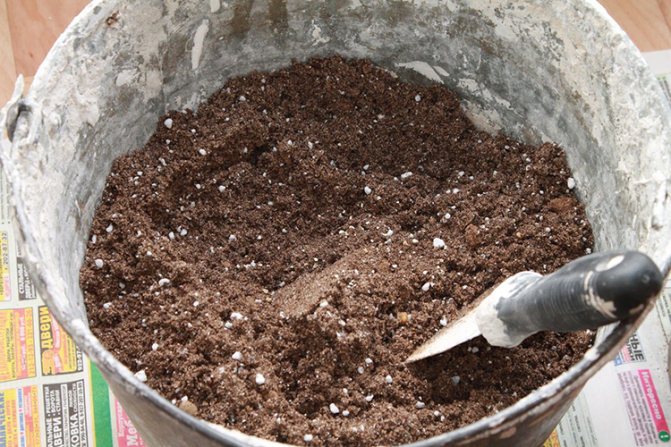

It is noted that the hybrid develops well in light and nutritious soil, with a high level of aeration. You can improve the composition of clay soil by adding sand. One bucket is required for 1 m2.
Preparing the landing site
It is recommended to combine work on the normalization of the soil composition with the installation of supports for the vineyard. For the first two seasons, you can limit yourself to a small stake, to which the growing shoots will be tied. As the culture grows, a strong trellis will be required, at least 3 m high.
Also, for plants, initially a pipe for root watering can be brought into the hole.However, its presence is optional.
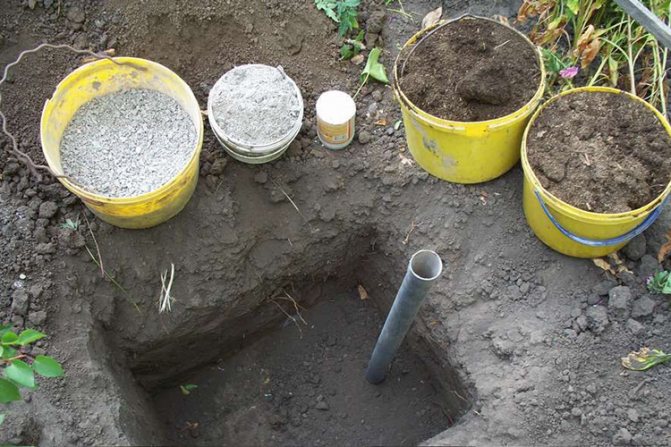

Planting holes should be dug in advance. The optimal size will be 80x80 cm. To fill the bottom layer, fertilizers are used - humus, ash and azofoska.
Rooting algorithm
Before planting, the seedling must be kept for a day in a container with a solution of potassium permanganate. Examine the root system, the roots of the culture should be well developed, not overdried.
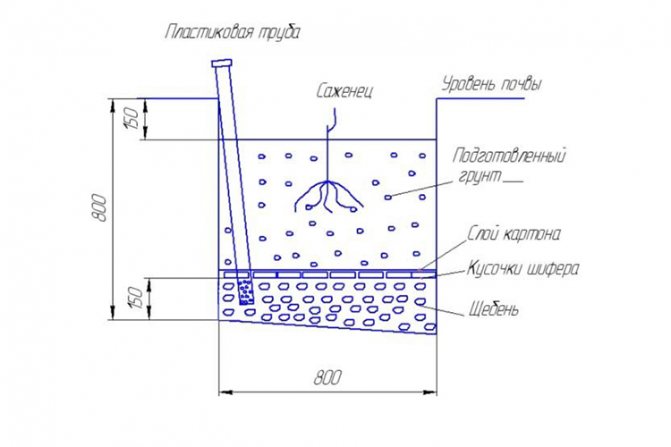

Landing includes the following works:
- a drainage layer is laid at the bottom of the pit - 10-15 cm;
- sprinkle it with a layer of fertilizer;
- from the remaining earth in the center of the hole I form a mound, place a seedling on it, straighten the roots;
- sprinkle on top with soil layer by layer, gently tamping, so that 1-2 buds remain above ground level;
- watering the seedling;
- mulch the soil around the bush.
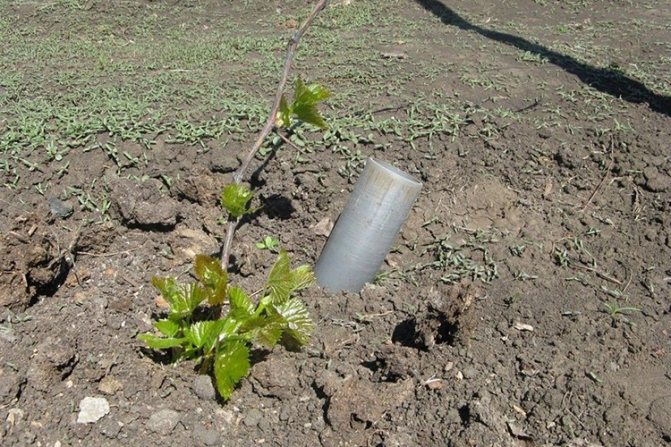

Grape care
Agricultural technology does not differ in its features. A large healthy bush will grow if the seedling, vineyard, and soil are selected correctly.
How to choose a seedling
Planting material in nurseries is divided into 4 classes:
- elite class. Healthy seedlings with four roots. Their thickness is 2 mm, they are evenly distributed near the trunk. Mature growths of 3-4 pcs., Height 25 cm. It is advisable to use such material, it gives an intensive growth and yield;
- first grade. It has two healthy growths up to 20 cm in height. The roots are relatively evenly distributed around the stem, at least 2 of them are 2 mm thick;
- second grade. Lags behind the first grade in terms of growth. The seedling has 3 matured nodes, at least 2 roots;
- substandard material. The growth nodes matured poorly or did not ripen at all. Such seedlings are grown before planting.
Landing dates
In climates with mild winters, grapes are planted in the fall. Before frost, the plant takes root. In winter, the seedlings are covered.
Spring warming is expected in the middle and northern regions. Stable above zero temperatures and warm soil are the best times for planting grapes.
The grapes grow in well-lit and shaded areas. Crosswinds damage the culture.
In cold latitudes, the southern or south-western side is chosen for the vineyard, protected by a wall or a solid fence from the winds.
It is necessary to check that the groundwater at the site does not lie higher than 2 m from the earth's surface. The soil is required fertile, light, with neutral acidity.
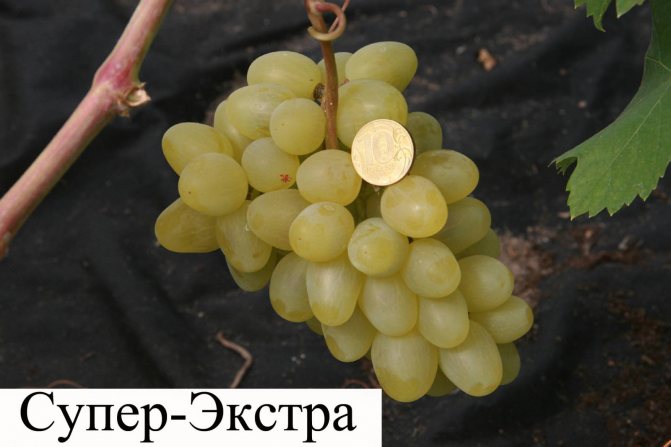

Before breaking up a vineyard, the site is dug up, loosened. The soil is mixed with organic matter, mineral fertilizers. A month before planting young plants, planting holes are dug. Their depth and width should be 80 cm.
The distance between the bushes should be kept 1.5-2 m, and between the rows - 3 m.
The bottom of the holes is covered with drainage (gravel, stones, crushed stone), a mound of earth is poured. A lot of water is poured into the pits and supports are installed.
Planting step by step
The roots of the seedling are soaked for a day in water with a root, then cut by 1 cm, treated with an antibacterial composition.
Detailed landing algorithm:
- The seedling is placed in a planting pit with an inclination towards the support.
- The rhizomes are evenly distributed over the mound of earth, giving them a downward direction.
- They cover it with earth, tamp it down.
- Watering.
When young plants take root, the branches will grow back, they are tied to a support.
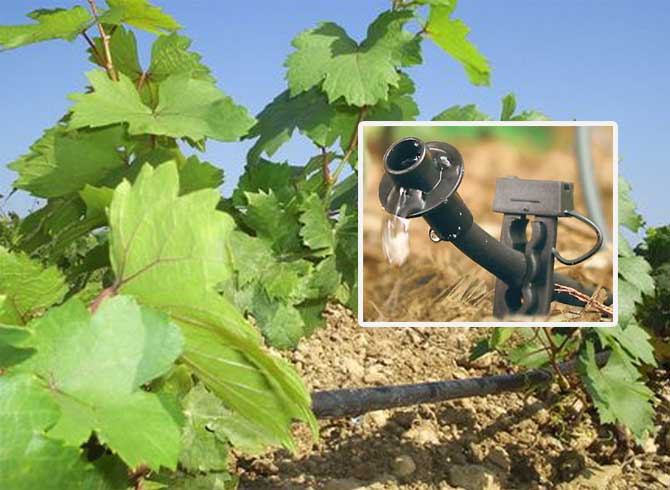

Watering the grapes requires moderate
The roots of the grapes penetrate deep into the ground, where moisture is always present. Therefore, Extra grapes are watered only in dry summers.
In just a season, it is enough to water the bush 3-4 times abundantly. During the period when the berries are poured, the grapes consume a lot of water. But 3 weeks before harvesting, watering is stopped so that the berries do not burst.
Top dressing
Without the help of the grower, the bush runs wild, the berries become smaller, sour, and the bush grows chaotically. Therefore, gardeners feed and prune the grapes.
Feeding schedule:
- first root. Carried out 2 weeks before flowering: 40-50 g of nitrophoska per 1 m² for better pollination;
- first foliar. 20 g of boric acid, 3 g of copper sulfate, 20-23 g of iron sulfate are dissolved in 10 liters of water. Top dressing is combined with fungicide treatment;
- second root. 2 weeks after flowering. Use 50-60 g of nitrophosphate per 1 m² so that the berries are poured with juice. Urea - 30-40 g, 15 g of ferrous sulfate, 1 g of potassium permanganate, 10-15 g of citric acid prevent chlorosis, as well as paralysis of the ridges;
- third root. 2 weeks before ripening. Superphosphate 20 g, potassium salt 15 g, potassium magnesium 1 tbsp. the spoon.
After harvesting, use the infusion of ash and potassium sulfate. Watered under the bush.
Pruning
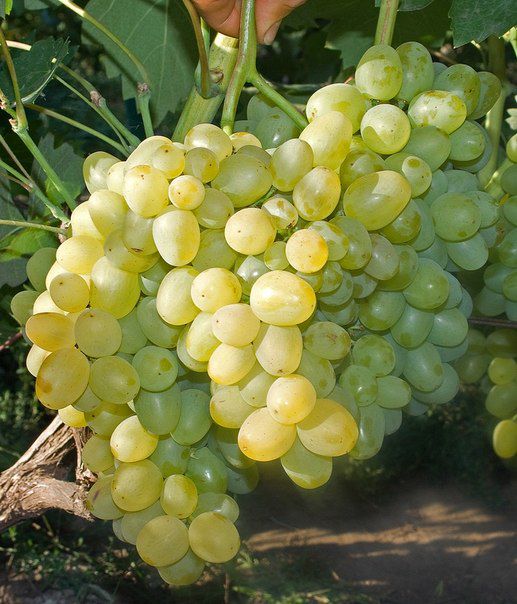

Several trimmings are made per season. Immediately after wintering, the grapes are planted on a trellis, shoots that have not wintered well are cut off. The vine can be spoiled by rodents. Such fragments are removed to a healthy kidney.
In the summer, stepchildren break out, remove excess shoots for better illumination and ventilation. Extra bunches are also removed in order to maintain the correct load of the bush with fruits.
Autumn pruning is carried out after leaf fall. Old shoots, underdeveloped and diseased branches will clearly appear on the bush. Leave 25 eyes, 6-8 for each branch.
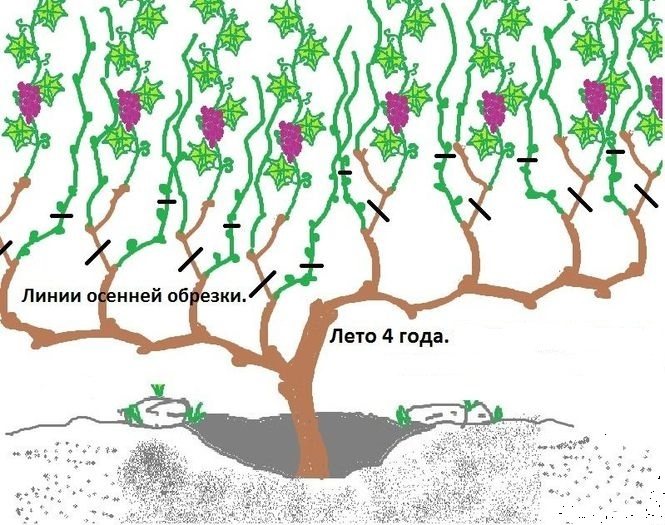

Pruning grapes is needed to form a bush
Shelter for the winter
It is not required in the southern regions. The trunk circle is mulched with rotted sawdust, manure.
To the north of the Rostov region, a shelter is being prepared for the vineyard. Before this, the vine is treated with Bordeaux liquid. The grapes removed from the support are tied, wrapped in breathable material (for example, burlap), laid in trenches that are dug along the rows, and sprinkled with earth.
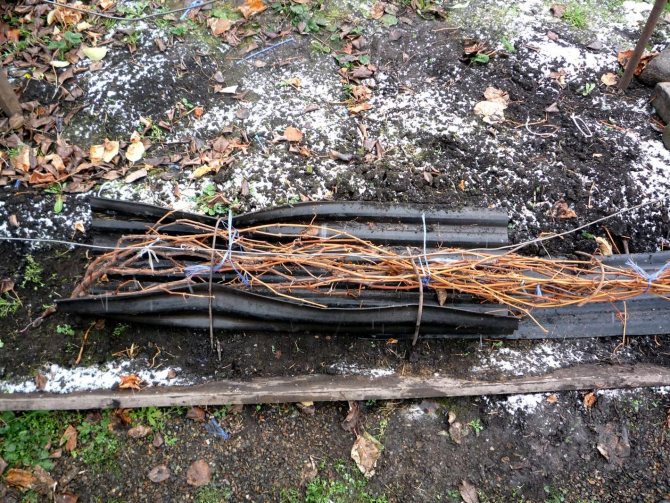

Shelter for the winter is required only where there are severe frosts in winter.
The following general rules for caring for Super Extra grapes should be adhered to:
- cover the soil near the seedlings with sawdust or moss after watering - this helps to retain moisture;
- shorten the shoots annually, while cutting off up to 9 eyes (the best time for the event is autumn);
- regularly carry out preventive measures (for example, spraying) that will help prevent diseases of the vine;
- water the bushes thoroughly (which is the key to high yields). Watering is especially important during fruit formation and flowering;
- use top dressing and organic fertilizers;
- cover the plant in the cold season (despite the fact that the variety is frost-resistant).
Advice! You can feed the grapes both by spraying the foliage and by applying top dressing to the soil.
Pruning grapes
Pruning is aimed at lightening the bush (in order to reduce the risk of disease, better ventilation) and at its formation. In the spring, it is recommended to remove badly overwintered and excess shoots. In the summer, they also get rid of unnecessary shoots. After flowering, remove excess clusters. The main pruning is done in the fall.
Important! It is recommended to leave 26 eyes on each bush. The load on 1 shoot is considered optimal in the presence of 2 bunches.
A fine mesh will save flies and other insects from eating fruits. Below is a photo from the archive of a gardener growing Super Extra grapes, which will give some idea of how you can protect the berries with a net.
You can also take care of the safety of the crop at the stage of setting. To do this, a week after flowering, it is necessary to spray the vine with Forchlorfenuron and Gibberellin fractions.
Wasps are especially fond of the Super Extra variety. Insects can infect both ripe berries and fruits that are beginning to ripen. It is recommended to immediately get rid of the hornets' nests found. Also, baits in the form of sweet mixtures with the addition of insecticides help. Ripe berries can also be pecked out by birds, so a scarecrow should be purchased.
Preparing a culture for winter is no different from preparing an ordinary covering grape. In the north and in the middle lane, it is required to remove the vines in late autumn and cover them. In the south, grapes can be left to winter on trellises.
For gardeners living in moderately cold regions, it is enough to cover the grapes with spruce branches of coniferous trees; gardeners living north of Moscow are advised to add roofing material. It is not necessary to bury the vines in the ground.
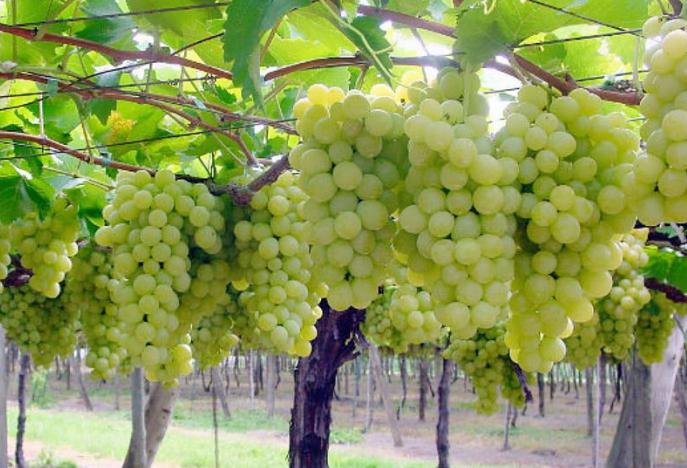

Super extra - unpretentious variety, feels good on any soil, but gives the best results on light, well-moistened soil. If the soil is heavy and clayey, then when planting a seedling it is worth mixing it with sand and adding humus or compost.
This grape is suitable for growing in cold regions, and you can get a good harvest from it even in the harsh continental climate of Siberia. In short summer conditions, it is better to plant the bushes on the south side, providing them with the maximum amount of sunlight.
Among other advantages of the variety, good resistance to fungal diseases of grapes. It is not susceptible to mildew and powdery mildew even in rainy areas. But even such a resistant variety will not be damaged by prophylactic spraying with Bordeaux liquid before flowering.
Watering such a moisture-loving variety needs regular watering: at least once every two weeks, each bush should be watered with 12-15 liters of water.
As for the procedures for shaping and pruning bushes, they must be done in the spring.
The procedure for growing Super Extra grapes is similar to other varietal grapes, taking into account some of the characteristics inherent in this hybrid.
- Site selection. The most suitable month for planting grapes is April, the place is being prepared in the fall. Agriculture prefers well-lit places, but it also feels good in partial shade. The variety grows on any type of soil, but gives the greatest preference to light, nutritious soil. Extra is characterized by tall growth, therefore it requires more space for the development of a bush in comparison with similar varieties. There should be a distance of at least 2.5 meters between the rows, preferably 3 meters. It is recommended to place seedlings at a distance of 2 meters. The increased stature requires careful calculation of the distance between the bushes when planting.
- Pit preparation. For planting, holes are dug 80 * 80 cm in size. 1 meter high, with large volumes of planting, it is advisable to dig a trench. A drainage layer in the form of crushed stone or pebble stone is distributed to the bottom of the pit. Then it is advisable to lead a small pipe with a diameter of 3-4 cm to the drainage. The installation will allow watering the bush directly into the roots in the first years. The bottom layer of the pit is filled with planting soil. To do this, the earth should be mixed with humus; with a clay layer, it is necessary to add sand per 1 sq. meter - 1 bucket of sand. It is also recommended to fertilize the soil with superphosphate 500 gr. and a bucket of ash.
- Installation of supports. Along with the planting pit, you need to take care of preparing the supports for the growth of the bush. In the first year, you will need a stake to tie up a young shoot, but over time, a strong trellis with a height of 3 meters or more will be required.
- Planting. The roots of seedlings are easy to dry, so you should not hesitate with planting. They plant it deep in the ground, leaving up to 2 buds on the surface. At first, it requires frequent watering and loosening of the soil.
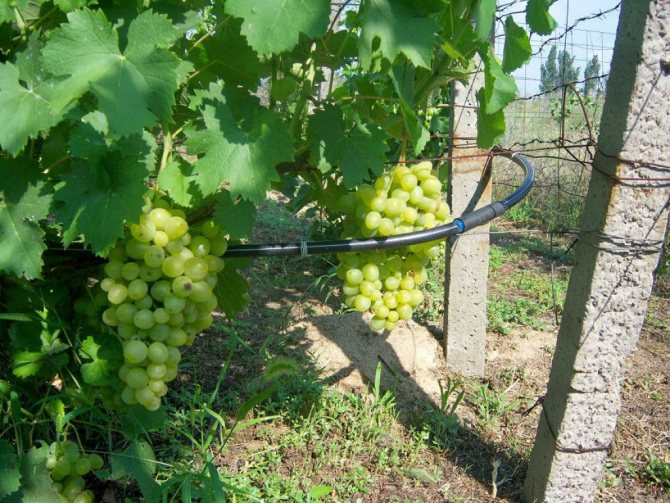

Super Extra grapes in the garden
How to care
After planting, the task of the gardener will be to provide appropriate conditions for the growth and development of a young culture. In order for the grapes to develop correctly, it is necessary to perform a number of mandatory care measures.
Watering
Bushes need a moderate introduction of moisture. It is recommended to water the seedlings, focusing on the state of the topsoil, avoiding excessive moisture. Particular attention should be paid to watering during the flowering and berry filling phase.For one plant, 1 bucket of water will be enough.
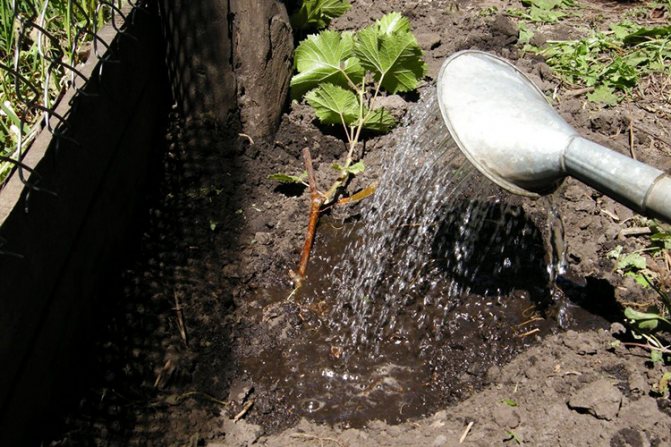

Mulching
Cover the soil around the bushes with a layer of mulch to retain moisture and eliminate the need for weeding. For these purposes, you can use moss, sawdust or chopped straw. The optimal thickness of the mulch layer will be 4 cm.
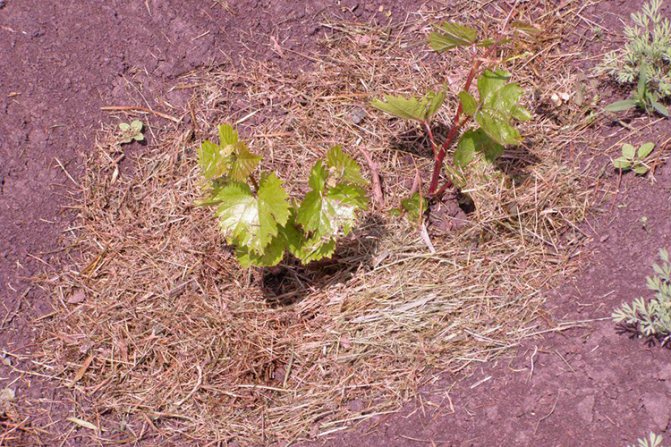

Pruning
The cultivar will require sanitary and formative pruning. It is carried out with the aim of thinning the shoots, since excessive thickening can lead to the development of fungal ailments. In the spring, the sanitary shaping of the vineyard is carried out - damaged and poorly overwintered shoots are removed.
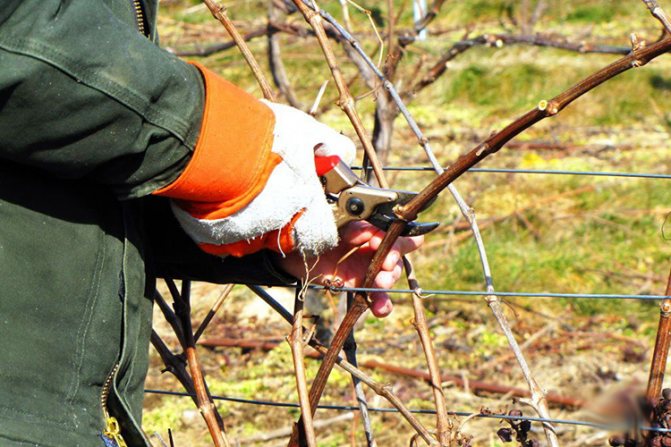

In the summer, the gardener will need to separate the extra stepsons; in the flowering phase, extra brushes are removed. The optimal number of clusters on one shoot will be no more than two.
The main work related to the formation of bushes is carried out in the fall, after leaf fall. During this period, the plantings are thinned out, leaving no more than 25 eyes on an adult plant - 6-8 pieces on each shoot.
Top dressing
The variety responds positively to the introduction of additional fertilizing into the soil, as well as spraying the aerial part with nutrients. For the vineyard, you will need to use humus, compost and wood ash annually.
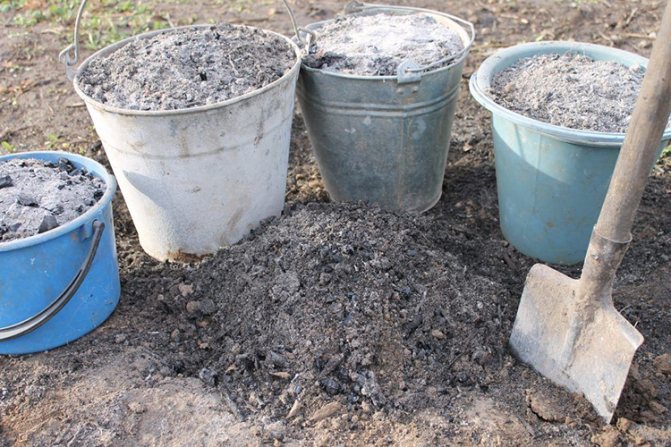

Outside, root fertilizers relate to spraying the bushes with mineral complex compounds. Work is carried out in the spring, before flowering, as well as in the growth phase of berries.
Diseases and pests
The hybrid is immune to most fungal ailments. However, preventive treatment against possible pathogens remains mandatory. The plantings are treated in the spring; a solution of ferrous sulfate is used for spraying.
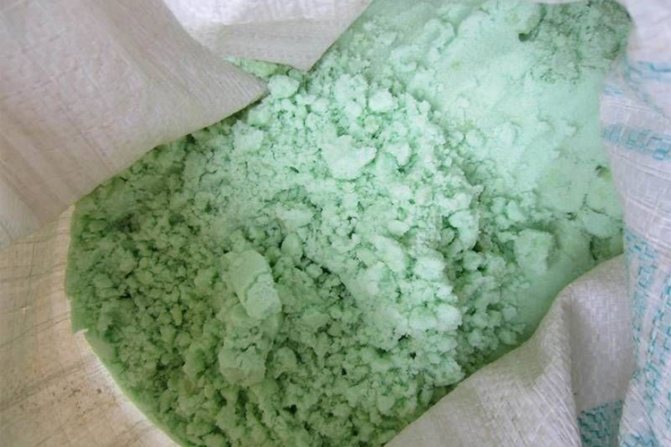

Ticks or aphids are not dangerous for the vineyard. However, wasps and flies can cause serious damage to the crop. Insect control is carried out by the systematic removal of wasp nests, sweet baits are also used, placed nearby, to which insecticides are added.
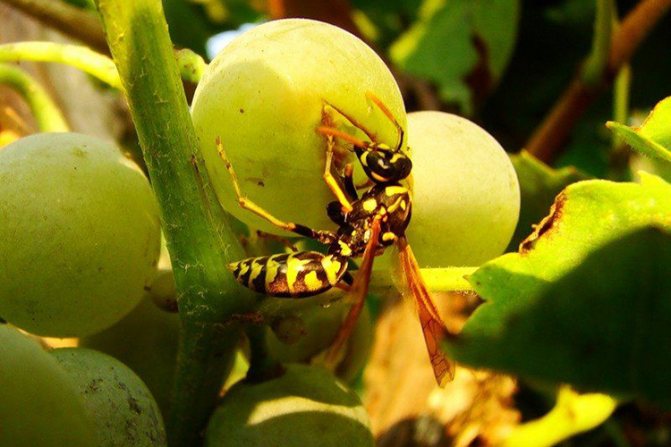

It is practiced to cover the brushes with special nets. Reflective objects and scarecrows are used to protect the crop from birds.
Preparing for winter
In the fall, the vine must be pruned and bent to the ground. Despite the frost resistance of Super-Extra, it should be additionally covered.
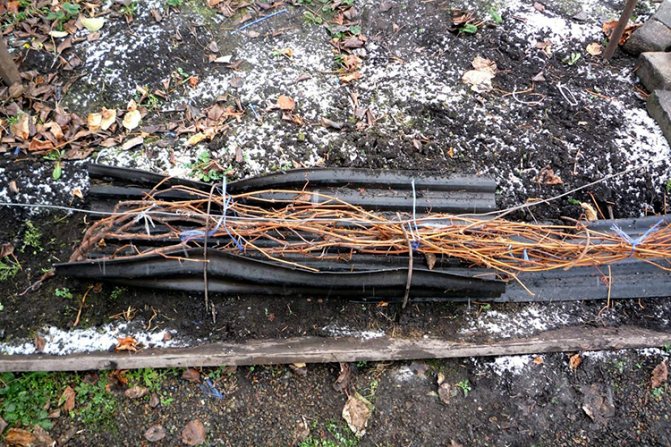

In the south, there will be a fairly thick layer of mulch, in the central and northern regions for vineyards it will be necessary to build a frame shelter covered with fiber or film, wooden boards or corrugated cardboard can be used as a base material.
Growing and care
General principles
Judging by the characteristics, the Super Extra variety is unpretentious. Grapes can be grown not only in different climatic zones, but also on almost any soil. Sand and humus must be added to clayey, heavy soil.
Choosing a place for planting seedlings should be sunny, especially if grapes are grown in Siberia in order to provide optimal conditions for a short summer.
It is advisable to plant on the southeast side of the house or fence. In this case, the plants will be protected from the winds. In addition, a wall of a house or a fence that heats up during the day will give Extre warmth at night.
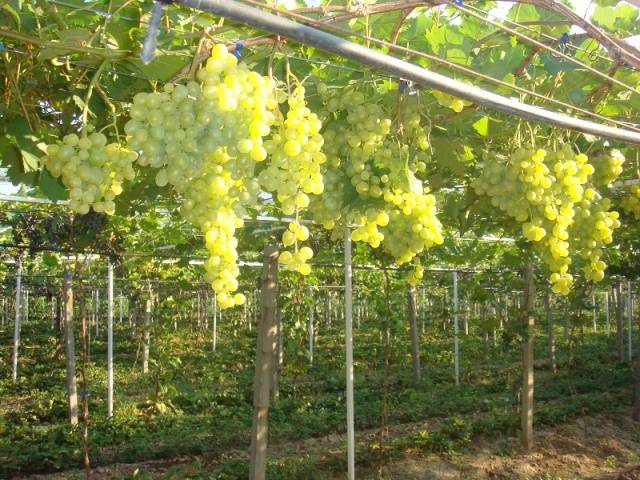

In regions with extreme climatic conditions, drought alternates with rain. These are excellent conditions for the defeat of the vineyard by fungi and pests. To protect grape plantings from fungal diseases, it is necessary to carry out preventive chemical treatments.
Advice! It is necessary to make it a rule to use Bordeaux liquid to spray the grapes before flowering.
Watering features
Super Extra grapes, judging by the description, needs competent watering. It is not necessary to fill it with water to the state of a swamp, but it is also not recommended to dry it out.Any deviation from the norm leads to a sharp decrease in the productivity and quality of berries. Abundant irrigation also leads to cracking of the berries, as they overflow with liquid.
Attention! Watering the grapes, if there is no rain, should be done once every 14 days; no more than 15 liters of water are poured under one bush.
What to feed
If you decide to seriously tackle the Super Extra variety, you need to study the features of feeding grapes. Fertilizers are applied without fail, without them the bush weakens and ceases to produce a decent harvest. The vineyard is fed both by the root and by the leaves. Both types of work are carried out several times per season. It is advisable to combine foliar feeding with disease prevention. Thanks to foliar feeding, plants more efficiently assimilate the resulting trace elements and nutrients.
Comment! Fertilizer rationing depends on the condition of the soil, climatic characteristics and the condition of the vineyard.
Useful video for gardeners about the rules for foliar feeding of grapes and protection against pests and diseases:
Pruning
To form the correct bush of grapes, it is necessary to carry out timely pruning. The fact is that Extra grows very much. A large number of stepchildren are formed on the shoots, which reduce the yield. In addition, overload may occur at the time of ovary formation. Excess inflorescences must also be plucked out.
During spring or autumn pruning, no more than 8 eyes are left on the shoots.
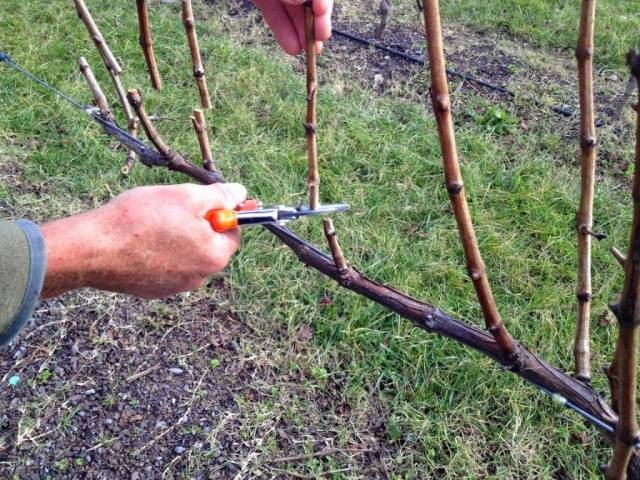

How to propagate Super Extra
The grapes of this variety are propagated in the usual ways: seedlings, cuttings and grafting. When planting new plants, the distance between bushes and row spacings must be taken into account. Since the bush grows strongly, it needs a large feeding area.
Reproduction
Several breeding methods are practiced.
Layering method
This option is considered the simplest and most effective. To get a new culture, in late autumn, the mother plant must choose an annual shoot, bend it to the ground in a special hole, 20-30 cm deep. Sprinkle with soil, apply a complex of mineral fertilizers.
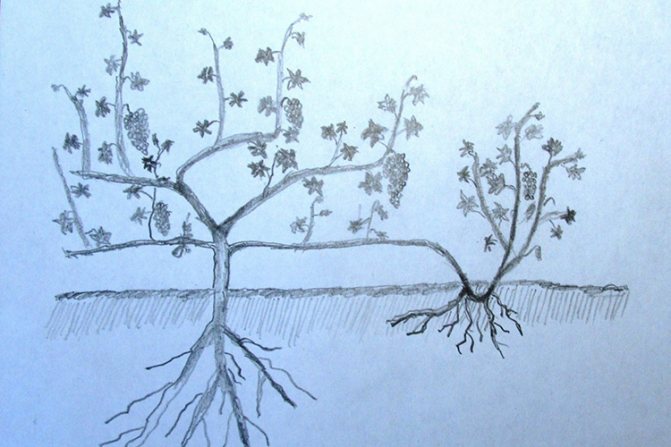

In the next season, new shoots will begin to form on the vine, after a year the cuttings can be separated along with the ground and rooted in the chosen place in the garden.
Cuttings
In the fall, annual shoots with 3-4 eyes are selected as planting material. They are cut into pieces of 15-20 cm, grown in containers with earth mixed with humus.
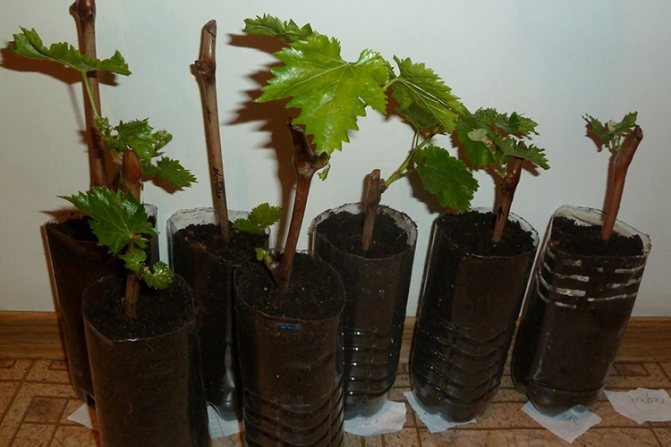

For rapid growth of the planting material, it is recommended to make a mini-greenhouse; for these purposes, you can use part of a plastic bottle or film. When the first leaves appear, the shelter must be removed, and the strengthened seedlings must be rooted in the open field.
Graft
A bush of a similar variety can be used as a rootstock. The grafting is done with a handle with 2-4 eyes. The planting material is cut from both sides, the upper part is treated with paraffin.
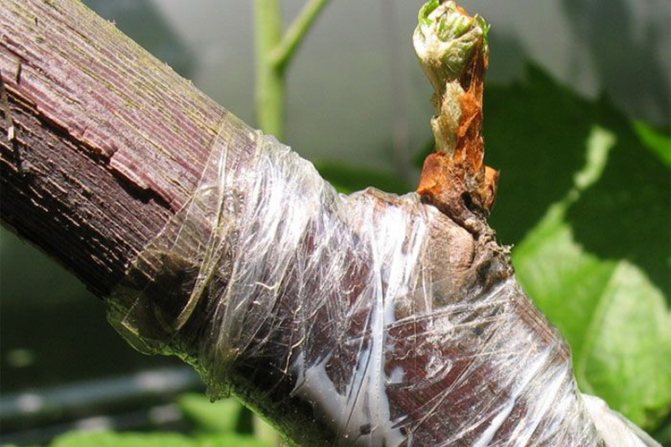

Before grafting, the cuttings are kept in water, then placed in a split made in the rootstock shoot, the junction is tightened with a cloth for better contact of the combined parts.
Testimonials
Vladimir, Izhevsk: I have been growing a variety on my site for several seasons. The vineyard annually pleases with large harvests, the berries are always large and juicy, a real storehouse of vitamins. The bushes perfectly tolerate any weather conditions, even with a rainy summer, the berries ripened tasty and without cracking.
Alexandra Ivanovna, Nikolaev: Super-Extra is very similar in size and taste to Arcadia, the only drawback for me was the very dense skin. But the grapes ripen very early, so the first harvest can be enjoyed already at the end of July. Average weight of brushes 500-600 g.
Alexander, Ryazan: An excellent option for our region.The harvest is stable, every year it is possible to collect beautiful and large clusters with sweet berries. Ripens closer to the second half of August. The berry does not grow smaller, the main thing is to protect the vineyard from birds and wasps. Several cans and sticky baits help keep the crop intact.
Disease prevention
As already noted, with resistance to mildew and mildew disease, Super Extra grapes are defenseless against phylloxera. Therefore, as a preventive measure, the bushes must be sprayed with Bordeaux liquid before flowering.
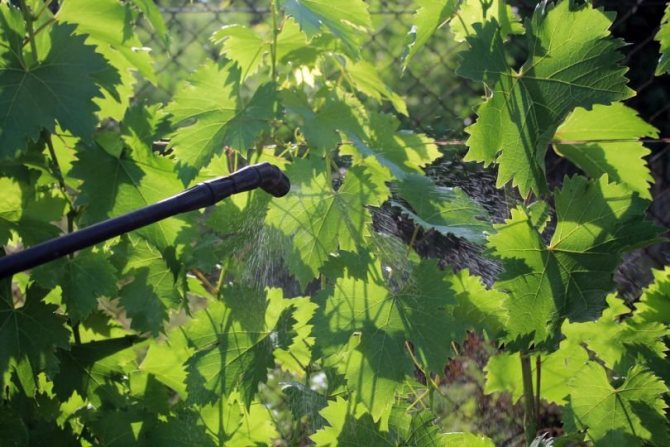

To prevent the invasion of dangerous phylloxera, it is best to use insecticides Actellik or Fozalon that are not washed off by rains and are safe for bees.
This variety is also not afraid of the invasion of ticks, but with excessive watering or in a rainy summer, berries bursting from an excess of moisture can be attacked by flies and wasps. Therefore, to prevent such attacks, it is necessary to cover the ripening clusters with a net.
The Super Extra grape variety justifies its name by super early ripening and extra ability to give a high yield in various climatic conditions, for which it is highly valued by winegrowers both in their summer cottages and on agricultural plantations.

